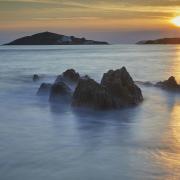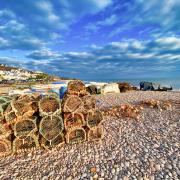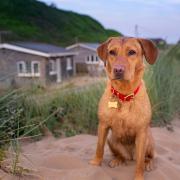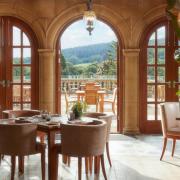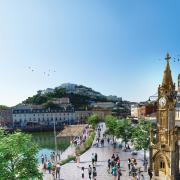During the winter months the coast can be a wild and rugged place, a place to witness nature's raw energy in the form of rolling, pounding surf, crashing on to and wearing away the shore.
Nowhere in Devon is this more so than on North Devon's Hartland coast, one of the county's remoter regions. Here, the coast is characterised by high, almost sheer cliffs, fronted by jagged rocks that make up most of the shoreline, facing directly west into the Atlantic. In winter the cliffs and rocks are regularly hammered by storm-driven surf, and even on calm days they retain a wild and untamed mood: this is Devon's wild frontier between the land and the open ocean.
Large parts of the Hartland coast are quite difficult to access, but one of the most easily reached places is Hartland Quay, marked by a cliffside hotel and the remnants of a small, long-abandoned harbour. Here the road comes to an abrupt end in the hotel car park, right next to some dramatic shoreline rocks and the ever restless surf. This is one of the best spots in North Devon to witness this wild frontier at any time of year, but especially during the winter months.
There's not just the surf rolling over the rocks and (at high tide) the harbour wall, but with its west-facing aspect there are also some fabulous Atlantic sunsets to be watched. Beyond Hartland Quay, reasonably straightforward hikes along the coast path lead to some spectacular views, to the north leading towards Damehole Point, shortly before Hartland Point, and to the south heading to the spectacular St Catherine's Tor - an enormous cliff that plunges straight into the sea - and then the beautiful waterfall at Speke's Mill Mouth, a cascade that pours down the cliffs and onto the beach.
One thing not to come to Hartland Quay for is sand: there is precious little of it, and even then it's only visible at low tide. No, the shores here are made up almost entirely of some very ferocious-looking rocks, steep, pointed and slippery. These are the ramparts defending Hartland against the wild winter Atlantic.

Atlantic sunset
The sun sets over the Atlantic, and over the rocky shoreline that characterises Hartland Quay. With so many rocks, at low tide rock pools abound, all quickly gobbled up by the rising tide, a fate about to befall the one in the foreground of this shot.

Rising tide
The light of the setting sun, just off the right-hand side of this scene, lights up and picks out some wonderful details in this set of jagged rocks, so typical of the Hartland coast. With the tide rapidly rising towards a high spring tide, this set of rocks was soon to largely disappear beneath the swirling waves.

Tide lines
On such a rocky shore as that found at Hartland Quay, sand is in short supply, but in those few areas where it can be found - almost wholly below the high tide line - the strong currents and powerful waves have sculpted it into some stunning geometric wave patterns. With the sun low in the sky, those patterns can be beautifully picked out in relief, their shapes exaggerated by the strong highlights and deep shadows cast by the sun.

Pounding surf
Lit by the flat evening light of dusk, Atlantic surf pounds the walls of the old (and long disused) harbour at Hartland Quay, slowly wearing it down.

Watery descent
A mile or so south of Hartland Quay, Speke's Mill Mouth is a bay at whose southernmost end a wonderful waterfall plunges down a narrow gorge cut into the cliffs, crashing from the cliff's heights to the rocky beach below. The waterfall makes its descent in three stages, working its way down the gorge in such a way that at no viewpoint are all three stage visible - alas. This image shows just the bottom section, where it finally reaches the shore and then flows away across the rocks to the sea. Be warned: this bottom part of the waterfall is accessible only for about three hours either side of low tide. If exploring here, don't get cut off!

A rugged coast
To the north of Hartland Quay stretch spectacular cliffs that lead all the way to Hartland Point a couple of miles away. In the evening sunlight every detail in the crevasses and outcrops is picked out in sharp relief, highlighting the sheer grandeur and ruggedness of this wild coast.

Elemental force
St Catherine's Tor, about half a mile south of Hartland Quay, is a spectacular cliff that plunges almost vertically into the sea. It is actually a hill whose seaward side has been almost literally chopped off by the eroding forces of sea, wind and rain. It is one of the most stunning features of this already magnificent coast.

Mists of time
On a grey, stormy day, a long exposure time has blurred out the waves pounding these rocks, converting the roaring waves to an almost peaceful ethereal mist, highlighting the sheer drama and jaggedness of Hartland's Atlantic coastline rocks.

Slipping into the sea
For views of sunset over the Atlantic Ocean, west-facing Hartland Quay is hard to beat, its rocky shores and cliffs offering some of the best and most dramatic - and most accessible - viewpoints anywhere along this coast.

Ocean serenity
Bathed in warm evening sunlight, a calm high tide view over the old walls of the harbour, gives a sweeping vista northwards along cliffs, culminating in the rocks of Damehole Point.

ABOUT NIGEL
Nigel Hicks is a professional photographer based in South Devon, whose travel, landscape and nature photography has seen him working all over the world. He runs regular photography workshops in the South West – including along the Hartland coast – and has published several books about the region, including Beautiful Devon and Wild Southwest. He is a regular contributor to Devon Life. nigelhicks.com


















